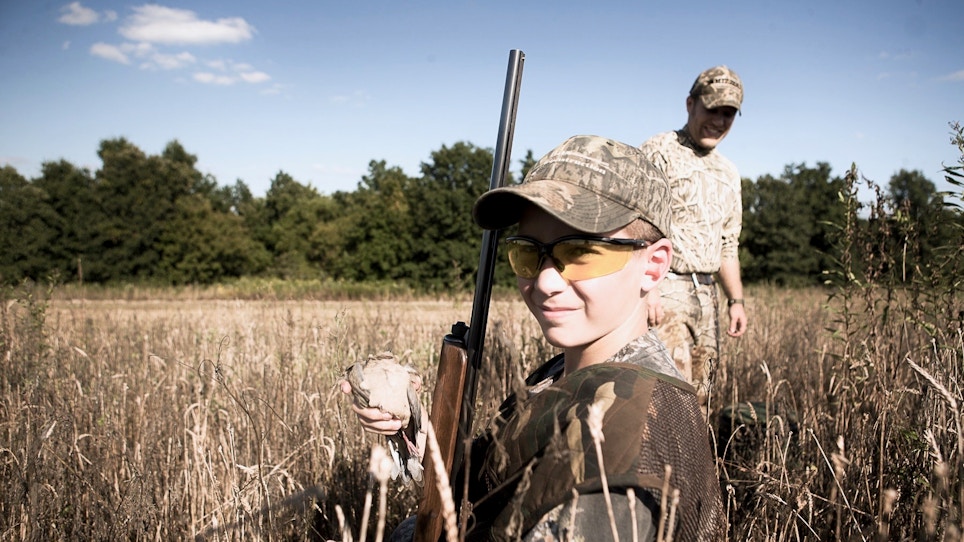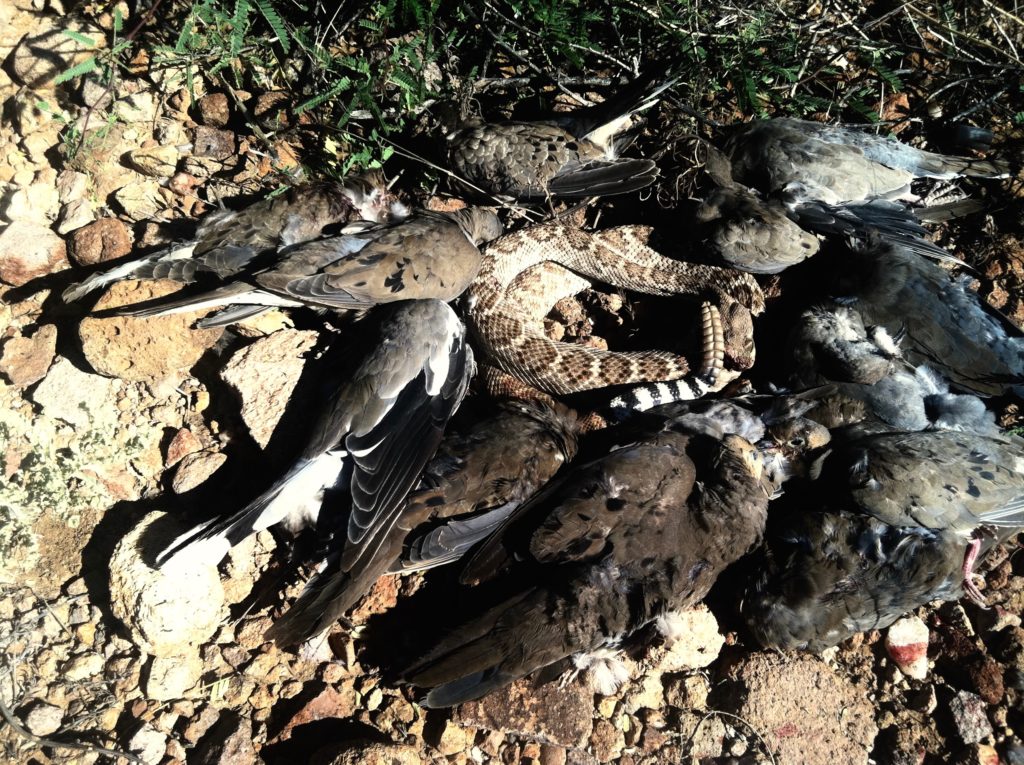
Smart shotgun hunters always pattern their shotgun/choke tube/ammo choice to make sure they are achieving optimum results.
The trouble with dove shooting isyour buddies are usually right there with you and see most of your misses. Sometimes, they even keep score! At the end of the day, their selective memory recalls only their good shots, but they have total recall of your bad ones.
In terms of pure ammunition cost, it can be less expensive to kill a deer or elk than a limit of doves. That's because the average number of shots needed to kill one dove is about four. That's almost two boxes for a 10-bird limit. Ammunition makers love dove shooters so much that, back when Ohio sportsmen lobbied to get the dove season opened there, ammo manufacturers helped lead the drive to get the season passed.
If you think you're the only one who has trouble hitting these little blurs, don't despair — it's almost everybody. And since there are about a half-billion doves in the lower 48 states, it’s easy to see you're in good company when the empty hulls outnumber birds in the bag.
How, then, do you up your odds on doves? Here are 10 surefire tips.
10. Pattern Your Shotgun
Take a few moments to pattern your shotgun before hunting. Few people do this, assuming that patterns are uniform and cover the entire circle with enough pellets to get the job done. It ain't always so. If your patterns show flagrant holes, try switching to a different load. By experimenting, you'll find the right shot size, powder dram equivalent and make of shotshell for your individual shotgun and choke tube. You’ll also determine the maximum range you can shoot before the pattern breaks down. It will make a big difference!
9. Scout
Do this as closely to opening day as possible. Scouting is critical to hot-dove shooting. By learning the flight path the birds are using between roosting areas and food fields or water holes, you can set up right under where the majority of birds will be flying. As the day progresses, stay alert to subtle shifts in this primary flight path, and adjust your position accordingly. The same is true when hunting fields. Doves often enter fields at the corners, but this isn't always so. Watch and see where most of the birds are coming in, and set up there.
8. Use Enough Gun
Choosing a shotgun is a lot like selecting a spouse — what turns me on won't necessarily flip your switch. However, there are several basics to consider when selecting a shotgun for dove shooting. That’s fodder for another column. What I mean is, don’t be a shotgun snob and go dove hunting with your pet 28 gauge when the birds are highly-pressured and flying high and hot. These conditions call for 12 or 20 gauge shotguns
The same with choke tube selection. When they’re close and fast, improved cylinder rocks. When they’re not, a modified tube might be a better choice. Most dove shooters like No. 8 shot, but I personally prefer No. 7½ shot for a little bit more knockdown power on the crazy birds I hunt most often.

This scenario is not unusual where I dove hunt in the deserts of southern Arizona. Just one reason snake chaps are part of my ‘gotta have it’ gear.
7. Camo Up
Wear camouflage or drab-colored clothing when hunting doves. White tee-shirts are a beacon that say "Danger — stay away!" If you're really serious about it, you'll wear light gloves and a net face mask, too. And when you set up, do so behind the cover of brush, under or next to a tree or in the shade. Hand in hand with drab clothing is not moving until the doves are within the sphere of your range markers. Movement will spook doves and send them into their aerial acrobatics instantly. They're tough enough to hit without giving them advanced warning.
6. Hunt Tactic No. 1: Hide
Standing in a randomly-chosen spot in a large field and banging away at doves with no forethought or planning is a guaranteed way to keep the ammo makers happy. By thinking out your hunt and following a game plan and staying hidden, your success will improve dramatically.
Bonus tip: Crazy as it might sound, more than once I have sat on a little stool in the wide open behind a Montana Decoys Big Red Moo Cow decoy and hammered ‘em. It can work amazingly well.
5. Hunt Tactic No. 2: Field Corners
Like all game animals (and fish, too), critters just seem to be drawn to edges and corners. When hunting big fields, I am always looking for something that breaks up the straight edges along roads or irrigation ditches. Often that’s a corner, where birds seem to whiz by a lot. Of course they don’t always do this, but they do it often enough that — when hunting unfamiliar terrain —that’s where I like to begin.
4. Hunt Tactic No. 3: Range Markers
A high percentage of doves are missed by shooting at birds out of range. Just because everyone around you is banging away doesn't mean you have to join in. Control your excitement and concentrate on shooting at birds that are in range.
Estimating distance can be tricky. To help, after selecting a stand or building a blind, set out some range markers. Tie a small piece of fluorescent flagging to a branch, bush, or rock 35 to 40 yards all around your hide, and don't shoot at birds that don't penetrate this circle.
I bring along a laser rangefinder for this. Sounds simple, doesn't it? And yet, this trick helped me up my shotshell-to-dove ratio more than anything I've ever tried. It kept me from shooting at birds beyond my capabilities. Decoys make good range markers by the way …
3. Hunt Tactic No. 4: Decoys
Speaking of decoys, I’ve found that prominently displaying a half-dozen dekes on a fence line, in a bare tree, or on a tall stick I've set up myself in a large, open field has produced shots I would otherwise not had. All the doves won't come look at the decoys, but enough do that I rarely ever head afield without them anymore.
Bonus tip: If they’re legal where you hunt and you’ve yet to try them, the Mojo (www.mojooutdoors.com) Voodoo Dove decoy is unbelievably effective. Using four AA batteries that spin the wings, these things suck in doves like there’s no tomorrow. I like them so much my best hunting buddy and I put out four of them. They list for $44.99, but I’ve seen them online for a tick over 30 bucks.
2. Accessorize
If you don’t like wearing a traditional bird shooter’s vest -- I don’t in hot weather -- wearing a waist-type belt with individual pouches for shot shells will get the weight of the shells off your shoulders and neck, reducing fatigue.
Two pair of polarized shooting glasses, one each with yellow and dark lenses, will improve your ability to pick up birds regardless of available light conditions. A removable shotgun sling will make carrying your shotgun long distances to hot-shooting areas away from the crowds more pleasant. If you’re going to be in one spot for a long time, a comfy folding stool is nice.
Never, ever forget sunscreen and bug dope. Who could forget the ice-filled cooler full of chilled beverages for hunting, and ice to keep dove breasts cool on the drive home? And for those of you who hunt in snaky places like I do, a pair of snake chaps isn’t a bad idea, either.
1. Be Quick, But Don’t Hurry
Legendary UCLA basketball coach John Wooden had a lot of great sayings in his day, and this is my favorite of all. When it comes to shooting at game — not just doves, but all game — timing is everything. So when the time’s right, take the shot — but don’t rush it.
I’m not the world’s best dove shot, but I am not the worst, either. I do what many good shooters do. This entails picking a single bird out of the approaching flock, mount the shotgun on or slightly behind the dove, swing the barrel right through it, see some daylight — the amount determined by the dove's speed, angle, and range — and firing while flipping the barrel forward slightly with pressure on the forend with my left hand.
That last little "flip" of the forend is a technique commonly used by top dove hunters, live pigeon shooters and waterfowlers. It does work. If I keep my head pressed firmly to the cheek piece, have my weight balanced on both feet, and swing from the ankles, not the hips, the chances are good that dove is on the barbecue.





